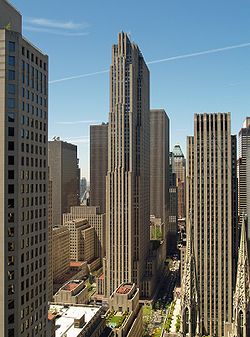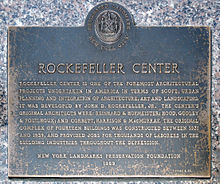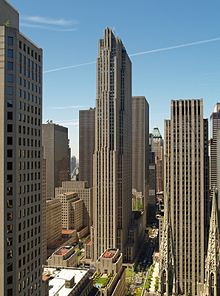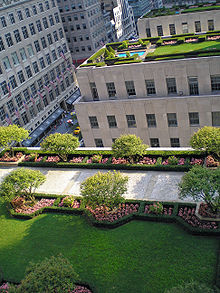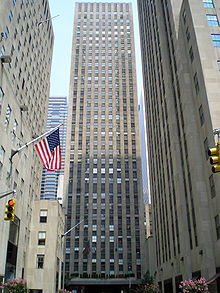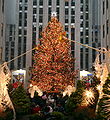- Rockefeller Center
-
Rockefeller CenterView of the GE Building at the heart of Rockefeller Center
Location: Midtown Manhattan, New York City, NY Coordinates: 40°45′31″N 73°58′45″W / 40.75861°N 73.97917°WCoordinates: 40°45′31″N 73°58′45″W / 40.75861°N 73.97917°W Area: 22 acres (8.8 ha) Built: 1939 Architect: Raymond Hood Architectural style: Modern, Art Deco Governing body: Tishman Speyer Properties, Mitsubishi Estate and other partners. NRHP Reference#: 87002591 Significant dates Added to NRHP: December 23, 1987[1] Designated NHL: December 23, 1987[2] Rockefeller Center or Rockefeller Plaza is a complex of 19 commercial buildings covering 22 acres (89,000 m2) between 48th and 51st streets in New York City, United States. Built by the Rockefeller family, it is located in the center of Midtown Manhattan, spanning the area between Fifth Avenue and Sixth Avenue. It was declared a National Historic Landmark in 1987.[2][3][4]
Contents
History
Rockefeller Center was named after John D. Rockefeller, Jr., who leased the space from Columbia University in 1928 and developed it from 1930. Rockefeller initially planned a syndicate to build an opera house for the Metropolitan Opera on the site, but changed his mind after the stock market crash of 1929 and the Metropolitan's continual delays to hold out for a more favorable lease, causing Rockefeller to move forward without them. Rockefeller stated "It was clear that there were only two courses open to me. One was to abandon the entire development. The other to go forward with it in the definite knowledge that I myself would have to build it and finance it alone."[5] He took on the enormous project as the sole financier, on a 27-year lease[6] (with the option for three 21-year renewals for a total of 87 years) for the site from Columbia; negotiating a line of credit with the Metropolitan Life Insurance Company and covering ongoing expenses through the sale of oil company stock. The initial cost of acquiring the space and razing some of the building and construction of new building was an estimated $250,000,000 dollars; a staggering sum in 1930. [7]
It was the largest private building project ever undertaken in modern times.[8] Construction of the 14 buildings in the Art Deco style (without the original opera house proposal) began on May 17, 1930 and was completed in 1939. Principal builder, and "managing agent", for the massive project was John R. Todd and principal architect was Raymond Hood, working with and leading three architectural firms, on a team that included a young Wallace Harrison, later to become the family's principal architect and adviser to Nelson Rockefeller.
It was the public relations pioneer Ivy Lee, the prominent adviser to the family, who first suggested the name "Rockefeller Center" for the complex, in 1931. Junior initially did not want the Rockefeller family name associated with the commercial project, but was persuaded on the grounds that the name would attract far more tenants.[9]
What could have become a major controversy in the mid-1930s concerned the last of the four European buildings that remained unnamed. Attempts were made by Ivy Lee and others to rent out the space to German commercial concerns and name it the Deutsches Haus. Junior ruled this out after being advised of Hitler's Nazi march toward World War II, and thus the empty office site became the International Building North.[10]
This subsequently became the primary location of the U.S. operations of British Intelligence, British Security Coordination (BSC) during the War, with Room 3603 becoming the principal operations center for Allied intelligence, organized by William Stephenson, as well as the office of the future head of what was later to become the Central Intelligence Agency, Allen Welsh Dulles.[11]
The Center is a combination of two building complexes: the older and original 14 Art Deco office buildings from the 1930s, and a set of four International-style towers built along the west side of Avenue of the Americas during the 1960s and 1970s (plus the Lehman Brothers Building). (The Time-Life Building, McGraw-Hill and News Corporation/Fox News Channel headquarters are part of the Rockefeller Center extension now owned/managed by the major private real estate firm, Rockefeller Group.)
In 1985, Columbia University sold the land beneath Rockefeller Center to the Rockefeller Group for 400 million dollars.[12] The entire Rockefeller Center complex was purchased by Mitsubishi Estate, a real estate company of the Mitsubishi Group, in 1989, which fully bought out Rockefeller Group. In 2000, the current owner Jerry Speyer (a close friend of David Rockefeller), of Tishman Speyer Properties, L.P., together with the Lester Crown family of Chicago, bought for $1.85 billion the older 14 buildings and land from the previous syndicated owners: Goldman Sachs (which had 50 percent ownership), Gianni Agnelli, Stavros Niarchos, and David Rockefeller, who organized the syndicate in 1996 and is historically associated with the other partners.[13]
Radio City Music Hall
Main article: Radio City Music HallRadio City Music Hall at 50th Street and Avenue of the Americas was completed in December, 1932. At the time it was promoted as the largest and most opulent theater in the world. Its original intended name was the "International Music Hall"[14] but this was changed to reflect the name of its neighbor, "Radio City," as the new NBC Studios in the RCA Building were known. RCA was one of the complex's first and most important tenants and the entire Center itself was sometimes referred to as "Radio City."
The Music Hall was planned by a consortium of three architectural firms, who employed Edward Durell Stone to design the exterior. Through the direction of Abby Rockefeller, the interior design was given to Donald Deskey, an exponent of the European Modernist style and innovator of a new American design aesthetic. Deskey believed the space would be best served by sculptures and wall paintings and commissioned various artists for thje large elaborate works in the theater. The Music Hall seats 6,000 people and after an initial slow start became the single biggest tourist destination in the city. Its interior was declared a New York City landmark in 1978. Painstakingly restored in 1999, the Music Hall interiors are one of the world's greatest examples of Art Deco design.
In 1979, after decades as a premiere showcase for motion pictures and elaborate stage shows, the theater converted to presenting touring performers and special events. Each holiday season features the annual musical stage show, the Radio City Christmas Spectacular, a tradition for more than 70 years. The enormous stage, with its elevators and turntables, has also offered Frank Sinatra, Ella Fitzgerald, the Grammy and Tony Awards, and countless other events. One of New York's most popular tourist attractions, the Music Hall has been attended by more than 300 million people.
GE Building (RCA Building)
Main article: GE BuildingRoof garden of Rockefeller Plaza buildings
The centerpiece of Rockefeller Center is the 70-floor, 872-foot (266 m) GE Building at 30 Rockefeller Plaza ("30 Rock", also the name of a comedy television show) formerly known as the RCA Building—centered behind the sunken plaza. The building is the setting for the famous Lunchtime atop a Skyscraper photograph, taken by Charles C. Ebbets in 1932 of workers having lunch, sitting on a steel beam, without safety harnesses. The 840-foot (260 m) drop lies below.
The building was renamed in the 1980s after General Electric (GE) re-acquired RCA, which it helped found in 1919. The famous Rainbow Room club restaurant is located on the 65th floor; the Rockefeller family office covers the 54-56th floors. The skyscraper is the headquarters of NBC and houses most of the network's New York studios, including 6A, former home of Late Night with David Letterman and Late Night with Conan O'Brien and current home of The Dr. Oz Show; 6B, and Late Night with Jimmy Fallon; 8H, home of Saturday Night Live; plus the operations of NBC News, MSNBC and local station WNBC. NBC currently owns the space it occupies in the building as a condominium arrangement.
Unlike most other Art Deco towers built during the 1930s, the GE Building was constructed as a slab with a flat roof, where the Center's newly renovated observation deck, the Top of the Rock[15] is located, which was first built in 1933. The $75 million makeover of the observation area was carried out by the Center's owner, Tishman Speyer Properties and was finally completed in 2005. It spans from the 67-70th floors and includes a multimedia exhibition exploring the history of the Center. On the 70th floor, reached by both stairs and elevator, there is a 20-foot (6.1 m) wide viewing area, allowing visitors a unique 360-degree panoramic view of New York City.[16]
At the front of 30 Rock is the Lower Plaza, in the very center of the complex, which is reached from 5th Avenue through the Channel Gardens and Promenade. The acclaimed sculptor Paul Manship was commissioned in 1933 to create a masterwork (see below) to adorn the central axis, below the famed annual Rockefeller Center Christmas Tree, but all the other original plans to fill the space were abandoned over time. It wasn't until Christmas Day in 1936 that the ice-skating rink was finally installed and the popular Center activity of ice-skating began.[17]
Center art
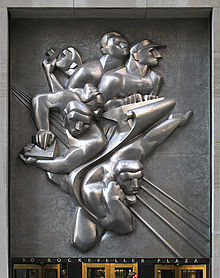 News by Isamu Noguchi.
News by Isamu Noguchi.
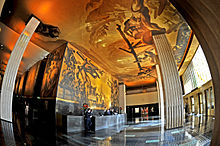 American Progress (back wall) and Time (ceiling), murals in the lobby of the GE Building, by Josep Maria Sert.
American Progress (back wall) and Time (ceiling), murals in the lobby of the GE Building, by Josep Maria Sert.
Rockefeller Center represents a turning point in the history of architectural sculpture: it is among the last major building projects in the United States to incorporate a program of integrated public art. Sculptor Lee Lawrie contributed the largest number of individual pieces — twelve — including the statue of Atlas facing Fifth Avenue and the conspicuous friezes above the main entrance to the RCA Building.
Paul Manship's highly recognizable bronze gilded statue of the Greek legend of the Titan Prometheus recumbent, bringing fire to mankind, features prominently in the sunken plaza at the front of 30 Rockefeller Plaza. The model for Prometheus was Leonardo (Leon) Nole, and the inscription from Aeschylus, on the granite wall behind, reads: "Prometheus, teacher in every art, brought the fire that hath proved to mortals a means to mighty ends." Although some sources cite it as the fourth-most familiar statue in the United States, behind the Lincoln Memorial, Mount Rushmore and the Statue of Liberty, Manship was not particularly fond or proud of it.[citation needed]
A large number of other artists contributed work at the Center, including Isamu Noguchi, whose gleaming stainless steel bas-relief, News, over the main entrance to 50 Rockefeller Plaza (the Associated Press Building) was a standout. At the time it was the largest metal bas-relief in the world. Other artists included Carl Milles, Hildreth Meiere, Margaret Bourke-White, Dean Cornwell, and Leo Friedlander.
In 1932, the Mexican socialist artist Diego Rivera (whose sponsor was Museum of Modern Art and whose patron at the time was Abby Aldrich Rockefeller, the wife of John D. Rockefeller, Jr.), was commissioned by their son Nelson Rockefeller to create a color fresco for the 1,071-square-foot (99 m2) wall in the lobby of the then RCA Building. This was after Nelson had been unable to secure the commissioning of either Matisse or Picasso. Previously he had painted a controversial fresco in Detroit entitled Detroit Industry, commissioned by Abby and John's friend, Edsel Ford, who later became a MoMA trustee.
Thus it came as no real surprise when Rivera's Man at the Crossroads became controversial, as it contained Moscow May Day scenes and a clear portrait of Lenin, not apparent in initial sketches. After Nelson issued a written warning to Rivera to replace the offending figure with an anonymous face, Rivera refused (after offering to counterbalance Lenin with a portrait of Lincoln), and so he was paid off and the mural papered over at the instigation of Nelson, who was to become the Center's flamboyant president. Nine months later, after all attempts to save the fresco were explored—including relocating it to Abby's Museum of Modern Art—it was destroyed as a last option.[18] (Rivera re-created the work later in Mexico City in modified form, from photos taken by an assistant, Lucienne Bloch.)
Rivera's fresco in the Center was replaced with a stunning, larger mural by the Spanish Catalan artist Josep Maria Sert, titled American Progress, depicting a vast allegorical scene of men constructing modern America. It contains the figures of Abraham Lincoln, Mahatma Gandhi and Ralph Waldo Emerson, and it is wrapped around the west wall of the Grand Lobby at 30 Rock.[19]
In 1962, a plaque was placed at the plaza with a list of principles in which John D. Rockefeller Jr. believed, first expressed by him in 1941. This is the full text:
"I believe in the supreme worth of the individual and in his right to life, liberty, and the pursuit of happiness.
I believe that every right implies a responsibility; every opportunity, an obligation; every possession, a duty.
I believe that the law was made for man and not man for the law; that government is the servant of the people and not their master.
I believe in the Dignity of labour, whether with head or hand; that the world owes no man a living but that it owes every man an opportunity to make a living.
I believe that thrift is essential to well ordered living and that economy is a prime requisite of a sound financial structure, whether in government, business or personal affairs.
I believe that truth and justice are fundamental to an enduring social order.
I believe in the sacredness of a promise, that a man's word should be as good as his bond; that character not wealth or power or position - is of supreme worth.
I believe that the rendering of useful service is the common duty of mankind and that only in the purifying fire of sacrifice is the dross of selfishness consumed and the greatness of the human soul set free.
I believe in an all-wise and all-loving God, named by whatever name, and that the individuals highest fulfilment, greatest happiness, and widest usefulness are to be found in living in harmony with His Will.
I believe that love is the greatest thing in the world; that it alone can overcome hate; that right can and will triumph over might."Buildings and tenants
The landmark buildings comprise over 8,000,000 square feet (743,000 m2) on 22 acres (89,000 m2) in Midtown, bounded by Fifth and Sixth Avenues, and running from 48th Street to 51st Street. Rockefeller Center is also a private property, co-owned by Tishman-Speyer, and open to the public.
- One Rockefeller Plaza (608,000 sq ft)—originally the Time–Life Building; an original tenant was General Dynamics, for whom the building was briefly named.
- 10 Rockefeller Plaza (288,000 sq ft)—Formerly the Eastern Air Lines Building. Originally called Holland House. Today Show studios[20] is located there.
- 30 Rockefeller Plaza (30 Rock): GE Building (2.9 million square ft)—Formerly the RCA & RCA West Buildings
- 1240 Avenue of the Americas: One of the original buildings on the site not torn down. It has been adapted as an annex building to 30 Rock.
- 50 Rockefeller Plaza: Bank of America Building (481,000 sq ft)—Formerly the Associated Press Building
- Originally built for the Associated Press, 50 Rock was the home to many news agencies. Isamu Noguchi's large, nine-ton stainless steel panel, News, holds the place of honor above the building's entrance. Noguchi's design depicts the various forms of communications used by journalists in the 1930s. The only building in the Center built out to the limits of its lot line, 50 Rock took its shape from main tenant's need for a single, undivided, loft-like newsroom as large as the lot could accommodate. At one point, four million feet of transmission wire were embedded in conduits on the building's fourth floor.
- 1230 Avenue of the Americas: Simon & Schuster Building (706,000 sq ft)[21] —Formerly U.S. Rubber/Uniroyal. Center Theatre prior to 1954.
- 1260 Avenue of the Americas: Radio City Music Hall
- 1270 Avenue of the Americas (528,000 sq ft)—Originally the RKO Building, later the American Metal Climax (AMAX) Building
- 600 Fifth Avenue (409,000 sq ft)—Formerly the Sinclair Oil Building
- 610 Fifth Avenue: La Maison Francaise (130,000 sq ft)
- 620 Fifth Avenue: British Empire Building (130,600 sq ft)
- 626 Fifth Avenue: Palazzo d'Italia (120,000 sq ft)
- 630 Fifth Avenue: International Building (1.2 million square ft)
- 636 Fifth Avenue: International Building North (120,000 sq ft)
The buildings above, those east of Sixth Avenue, are managed by Tishman-Speyer, the co-owner of Rockefeller Center. The buildings west of Sixth Avenue are managed and/or co-owned by the Japanese-owned Rockefeller Group:
- 1271 Avenue of the Americas (Time-Life Building)
- 1221 Avenue of the Americas (McGraw-Hill Building)
- 745 Seventh Avenue (Barclays Capital, formerly Lehman Brothers Building): Building now owned by Barclays Capital, the land by the Rockefeller Group.
Former buildings
- The Center Theatre (formerly the RKO Roxy Theatre; the only structure in the original Rockefeller Center to be demolished)
- 75 Rockefeller Plaza (originally the Esso Building, later the Time Warner Building)
- AXA Equitable Building (formerly the Sperry Rand Building), 1290 Avenue of Americas
- Hilton New York Hotel & Towers (formerly The New York Hilton at Rockefeller Center)
- 1251 Avenue of the Americas (originally Standard Oil [NJ], later Exxon Building)
- 1211 Avenue of the Americas (Originally the Celanese Building, sometimes known as the News Corp. Building)
- For a short time in the late 1950s, the Center also owned the original Roxy Theatre. The Roxy was purchased to obtain the air-rights to build the Time & Life Building. Once that building went up, the theater was sold and replaced by an office building. This building, while not part of the Center, is now connected to the Time & Life Building.
The underground Concourse
A series of underground pedestrian passages stretches from 47th Street to 51st Street, and from Fifth Avenue to Seventh Avenue. Numerous businesses operate in the Concourse offering shoppers a range of products and services. There are also eating establishments and a post office. Access to the Concourse is available in several ways. There are stairways leading down from the lobbies in the cluster of six landmark buildings. Access can also be gained through the restaurants at the skating rink, via the elevators to the north and south of the rink. The rink itself is on the concourse level. Additionally, there is access to the western entrance of the Concourse through the 47–50th Streets subway station below Sixth Avenue (B D F M trains). The largest independent burger restaurant in the United States is set to open in the spring 2010.[22]
Flags
 The Flags on Memorial Day weekend
The Flags on Memorial Day weekend
At street level, the plaza has about 200 flagpoles. At varying intervals, the flags of United Nations member countries, the flags of United States states and territories, or various decorative and seasonal flags are flown; during U.S. holidays, every flagpole carries the Flag of the United States.[23]
Gallery
View of New York City from the rooftop of Rockefeller Center.
-
The GE Building at night
-
Christmas at Rockefeller Center
-
Prometheus at Rockefeller Center
Lego set
In November 2010, former architect and Lego fan Adam Reed Tucker designed a Lego replica of the center for the LEGO Architecture series.
See also
- 47th–50th Streets – Rockefeller Center (IND Sixth Avenue Line)
- Architecture of New York City
Notes and references
- ^ "National Register Information System". National Register of Historic Places. National Park Service. 2007-01-23. http://nrhp.focus.nps.gov/natreg/docs/All_Data.html.
- ^ a b "Rockefeller Center". National Historic Landmark summary listing. National Park Service. 2007-09-18. http://tps.cr.nps.gov/nhl/detail.cfm?ResourceId=2027&ResourceType=Building.
- ^ "Rockefeller Center", by Carolyn Pitts, undated "National Register of Historic Places Inventory-Nomination". National Park Service. undated. http://pdfhost.focus.nps.gov/docs/NHLS/Text/87002591.pdf "Rockefeller Center", by Carolyn Pitts, undated.
- ^ Rockefeller Center--Accompanying photos, c.1933 to c.1986 "National Register of Historic Places Inventory-Nomination". National Park Service. undated. http://pdfhost.focus.nps.gov/docs/NHLS/Photos/87002591.pdf Rockefeller Center--Accompanying photos, c.1933 to c.1986.
- ^ Okrent, Daniel, Great Fortune, Penguin Books, 2003, p. 133.
- ^ Page 431 of http://www.scu.edu/law/FacWebPage/Glancy/assets/images/Urban.pdf
- ^ "Radio City to Cost $250,000,000." Popular Science Monthly, September 1930, p. 19.
- ^ Largest private building project—see Christine Roussel, The Art of Rockefeller Center, New York: W.W. Norton & Company, 2006, (p.11).
- ^ Ivy Lee and naming the Center—see Daniel Okrent, Great Fortune: The Epic of Rockefeller Center, New York: Viking Press, 2003. (p. 258)(ISBN 0-670-03169-0)
- ^ Okrent, Great Fortune, (pp.282–5)
- ^ Forerunner of the CIA in the Center—Okrent, Great Fortune, (p411); James Srodes, Allen Dulles: Master of Spies, Washington: Regnery Publishing, Inc., 1999. (p.207, 210)
- ^ Dunlap, David W. (June 3, 1993). "G.E. Gives Midtown Tower To Columbia University". The New York Times. http://query.nytimes.com/gst/fullpage.html?res=9F0CEED81538F930A35755C0A965958260. Retrieved May 22, 2010.
- ^ David Rockefeller's syndicate—Memoirs. New York: Random House, 2002.(p.479)
- ^ "World's Largest Theater in Rockefeller Center Will Seat Six Thousand Persons" Popular Mechanics, August 1932
- ^ Top of the Rock
- ^ Details of the Top of the Rock viewing area
- ^ Ice-skating commenced in 1936—see Roussel, The Art of Rockefeller Center, op. cit., (p. 199)
- ^ The Diego Rivera fresco incident—see Bernice Kert, Abby Aldrich Rockefeller: The Woman in the Family. New York: Random House, 1993. (pp.352–65); Cary Reich, The Life of Nelson A. Rockefeller: Worlds to Conquer, 1908–1958, New York: Doubleday, 1996. (pp.105–11)
- ^ The Sert fresco—see Roussel, The Art of Rockefeller Center, op. cit., (pp.94–107)
- ^ "[1]
- ^ "Contact Info." CBS Corporation. Retrieved on November 3, 2009.
- ^ Fabricant, Florence (January 26, 2010). "The Next Bill’s Bar and Burger Will Be Huge". NYTimes.com. http://dinersjournal.blogs.nytimes.com/2010/01/26/the-next-bills-bar-and-burger-will-be-huge/.
- ^ http://www.virtualtourist.com/travel/North_America/United_States_of_America/New_York_State/New_York_City-841252/Things_To_Do-New_York_City-Rockefeller_Center-BR-3.html
Further reading
- Dirk Stichweh: New York Skyscrapers. Prestel Publishing, Munich 2009, ISBN 3791340549
- Balfour, Alan. Rockefeller Center: Architecture as Theater, New York: McGraw-Hill, Inc., 1978.
- Deal, Martha. "Who Posed for the Statue of Prometheus" (Ray Van Cleef and Leon Nole). Iron Game History. Volume 6, Issue 4, Pages 34–35.
- Harr, John Ensor, and Peter J. Johnson. The Rockefeller Century: Three Generations of America's Greatest Family, New York: Charles Scribner's Sons, 1988.
- Karp, Walter. The Center: A History and Guide to Rockefeller Center, New York: American Heritage Publishing Company, Inc., 1982.
- Carol Herselle Krinsky, Rockefeller Center, New York: Oxford University Press, 1978.
- Loth, David G. The City Within a City: The Romance of Rockefeller Center, New York: Morrow, 1966.
- Okrent, Daniel. Great Fortune: The Epic of Rockefeller Center, New York: Viking Press, 2003.
- Reich, Cary. The Life of Nelson A. Rockefeller: Worlds to Conquer 1908–1958, New York: Doubleday, 1996.
- Roussel, Christine. The Art of Rockefeller Center, New York: W.W. Norton & Company, 2006.
External links
- Official website
- Guide to Rockefeller Center
- The Rockefeller Group
- Rockefeller Center Webcam
- in-Arch.net: Rockefeller Center introduction
- How to Ruin a Safe Bet; Did Rockefeller Center Financiers Reach Too Far? A 1995 New York Times article analyzing the REIT and the sale of Rockefeller Center.
- 40°45′34″N 73°58′42″W / 40.759487°N 73.978356°W
Popular visitor attractions in New York City Times Square (35M) • Central Park (20M) • Metropolitan Museum of Art (5.2M) • Statue of Liberty (4.24M) • American Museum of Natural History (4M) • Empire State Building (4M) • Museum of Modern Art (2.67M)
Streets and Avenues of Manhattan North–South South St · Essex St · Ludlow St · Orchard St · Allen St · Forsyth St · Chrystie St · Catherine St/Catherine Slip · Chatham Sq · Front St · Gay St · Pearl St/Bowery · Mott St · Mulberry St · City Hall Ln/Coenties Alley · Coenties Slip · William St · Centre Market Pl · Jones St · Centre St · Broad St/Nassau St/Lafayette St · Whitehall St · Broadway · Trinity Pl · Church St · University Pl · West Broadway · MacDougal St · Patchin Pl · Varick St · Hudson St · Greenwich St · Washington St · Weehawken St · West Side Elvtd Hwy/West StEast River Dr/FDR Dr · Ave D · Ave C/Loisaida Ave · Ave B/East End Ave · Ave A/Beekman Pl/Sutton Pl/York Ave/Pleasant Ave · First Ave · Second Ave · Third Ave · Irving Pl/Lexington Ave · Fourth Ave/Park Ave · Vanderbilt Ave · Madison Ave · Fifth Ave/Museum Mile · Rockefeller Plaza · Sixth Ave/Ave of the Americas/Lenox Ave/Malcolm X Blvd · Longacre Sq/Times Sq · Seventh Ave/Adam Clayton Powell Jr. Blvd · Shubert Aly · Great White Way · Eighth Ave/Central Park West/Frederick Douglas Blvd · Columbus Cir · Manhattan Ave · Ninth Ave/Columbus Ave/Morningside Dr · Dyer Ave · West Side Hwy/Tenth Ave/Amsterdam Ave · Eleventh Ave/West End Ave · Riverside Dr · Joe DiMaggio Hwy/12th Ave · 13th Ave · Miller Hwy/Henry Hudson PkwyHarlem River Dr · Audubon Ave · Duke Ellington Cir · Frederick Douglass Cir · St. Nicholas Ave · Juan Pablo Duarte Blvd · Strivers' Row · Morningside Ave · Claremont Ave · Ft. Washington Ave · Pleasant Avenue · Cabrini BlvdEast–West Bank St. · Bridge St · Brewers St/Stone St · Wall St · Liberty St · Maiden Ln · Fulton St · Vesey St · Ann St · Park Row · Roosevelt St · Chambers St · Cherry St · Henry St · Worth St/Justice John M. Harlan Way/Ave of the Strongest · East Broadway · Doyers St · N. Moore St · Beach St · Canal St · Hester St · Grand St · Delancey St · Rivington St · Stanton St · Leonard St · Houston St
1st–14th Sts — 1st St · Bleecker St · 2nd St · 3rd St/Great Jones St · 4th St · 6th St · Waverly Pl/Washington Square North · Astor Pl/Washington Mews · 8th St/St. Mark's Pl/Greenwich Ave · Christopher St · Stuyvesant St · 10th St · 13th St · 14th St15th–22nd Sts — 17th St
23rd–41st Sts — 23rd St · 24th St · 25th St · 26th St · 27th St/Club Row · 28th St · 29th St · 30th St · 31st St · 33rd St · 34th St · 35th St · 36th St · 37th St · 38th St · 39th St · 40th St · 41st St
42nd–59th Sts — 42nd St · 45th St · 47th St · 50th St · 51st St · 52nd St/Swing Alley/St of Jazz · 53rd St · 54th St · 55th St · 57th St · 58th St · 59th St/Central Park South60th–215th Sts — 66th St/Peter Jennings Way · 72nd St · 79th St · 85th St · 86th St · 89th St · 93rd St · 95th St · 96th St · 110th St/Cathedral Pkwy/Central Park North · 112th St · 116th St · 120th St · 122nd St/Mother Hale Way/Seminary Row · 125th St/Dr. Martin Luther King Jr. Blvd · 130th St/Astor Row · 132nd St · 139th St/Strivers' Row · 145th St · 155th St · Trans-Manhattan Expwy · 178th–179th St Tls · 181st St · 187th St · Bogardus Pl · Dyckman StItalics indicate streets no longer in existence.
See also: Commissioners' Plan of 1811 and List of eponymous streets in New York City.Categories:- Buildings and structures completed in 1939
- Art Deco skyscrapers
- Buildings associated with the Rockefeller family
- National Historic Landmarks in New York City
- Buildings and structures on the National Register of Historic Places in Manhattan
- Visitor attractions in New York City
- Rockefeller Center
- Shopping malls in New York City
- Skyscrapers in New York City
- Art Deco buildings in New York City
- Visitor attractions in Manhattan
Wikimedia Foundation. 2010.

